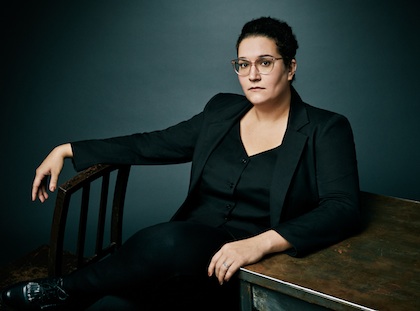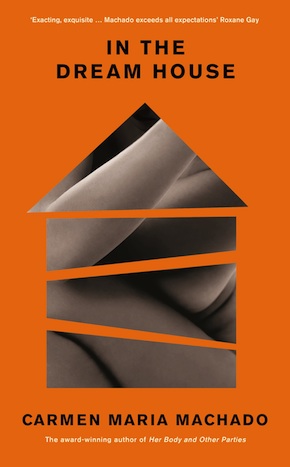From In the Dream House
by Carmen Maria MachadoAn engrossing and wildly innovative account of love gone bad, Carmen Maria Machado’s In the Dream House traces the full arc of a harrowing relationship with a charismatic but volatile woman. In a bold dissection of the mechanisms and cultural representations of psychological abuse, smashing the stereotype of lesbianism as safe and utopian, each chapter views her experiences through a different lens.
As Machado holds events up to the light and examines them from distinct angles, she explodes our ideas and expectations of memoir…
Dream House as World Building
Places are never just places in a piece of writing. If they are, the author has failed. Setting is not inert. It is activated by point of view.
Later, you will you learn that a common feature of domestic abuse is ‘dislocation’. That is to say, the victim has just moved somewhere new, or she’s somewhere where she doesn’t speak the language, or has been otherwise uprooted from her support network, her friends or family, her ability to communicate. She is made vulnerable by her circumstance, her isolation. Her only ally is her abuser, which is to say she has no ally at all. And so she has to struggle against an unchangeable landscape that has been hammered into existence by nothing less than time itself; a house that is too big to dismantle by hand; a situation too complex and overwhelming to master on her own. The setting does its work.
This world might as well have been an island, surrounded by impassable waters. On one side, a golf course – owned by the university, as was the house – where drunk undergrads would stagger like zombies, silhouetted on the hill. On another, a stand of trees that suggested a forest, mysterious and laced with wildlife and darkness. Nearby, houses occupied by strangers who either never heard or didn’t want to get involved. Last, a road, but the sort of road that led to another road, a larger one. Unfriendly to pedestrians. Not meant to be traversed, really. Miles from the town’s center.
The Dream House was never just the Dream House. It was, in turn, a convent of promise (herb garden, wine, writing across the table from each other), a den of debauchery (fucking with the windows open, waking up with mouth on mouth, the low, insistent murmur of fantasy), a haunted house (none of this can really be happening), a prison (need to get out need to get out), and, finally, a dungeon of memory. In dreams it sits behind a green door, for reasons you have never understood. The door was not green.
There is something desperate about the house; like a ghost is trying to make itself known but can’t, and so it just flops facedown into the carpet, wheezing and smelling like mold.”
Dream House as Set Design
The scene opens on a nondescript house in a neighborhood on the outskirts of Bloomington, Indiana, a few years after the close of the aughts. It’s a suburb, but one fringed with wildness; animals move over the property as though no one occupies it at all. A front door faces the street, but this door will remain closed. The driveway leisurely loops up the left side of the property like a creek, a mailbox at its mouth. The shingles are off-white; a red chimney is the only hint of character. Behind the house is a large tree with a wooden swing dangling from a low branch. It is opposite the only door the residents will ever enter: a back door that leads into the kitchen.
The kitchen – like the rest of the house – is filled with a combination of the dense, dark wood furniture you helped her move down the stairs of her last place, and broken, mismatched pieces from the previous owner. A standing lamp with a fraying electrical cord; a small kitchen table; a creaking sofa whose springs are like peas beneath a princess’s mattress. The house is functionally a circle: a kitchen that opens into the living room, which opens into a hallway from which the bedroom and bathroom protrude, which leads into an office, which loops back into the kitchen. In the bedroom: piles of clothing, stacks of books, a bright purple dildo, a bottle of men’s cologne shaped like a headless torso – Jean Paul Gaultier’s ‘Le Male’ – half-empty. In the kitchen: a bamboo salt cellar for artisanal sea salt, weirdly dull knives.
Everywhere in the house, there are cardboard boxes. Not new ones, either: they are soft and smell sweet like Pizza Hut boxes damp with grease. (Like Angela Carter’s Beast in ‘The Tiger’s Bride’, “The palace was dismantled, as if its owner were about to move house or had never properly moved in; The Beast had chosen to live in an uninhabited place.”) It is a bizarre mix of money and trash: like the belongings of a fallen aristocratic family. There is something desperate about the house; like a ghost is trying to make itself known but can’t, and so it just flops facedown into the carpet, wheezing and smelling like mold.
The curtain rises on two women sitting across from each other: CARMEN, a racially ambiguous fat woman in her mid-twenties with terrible posture. She is typing away on her computer. Across from her, THE WOMAN IN THE DREAM HOUSE, white, petite, and boyish, also typing, her jaw set hard. Around them, the house inhales, exhales, inhales again.
The house is not essential for domestic abuse, but hell, it helps: a private space where private dramas are enacted behind, as the cliché goes, closed doors.”
Dream House as American Gothic
A narrative needs two things to be a gothic romance. The first, ‘woman plus habitation’. “Horror,” film theorist Mary Ann Doane writes, “which should by rights be external to domesticity, infiltrates the home.” The house is not essential for domestic abuse, but hell, it helps: a private space where private dramas are enacted behind, as the cliché goes, closed doors; but also windows sealed against the sound, drawn curtains, silent phones. A house is never apolitical. It is conceived, constructed, occupied, and policed by people with power, needs, and fears. Windex is political. So is the incense you burn to hide the smell of sex, or a fight.
The second necessary element: ‘marrying a stranger’. Strangers, feminist film theorist Diane Waldman points out, because during the 1940s – the heyday of gothic romance films like Rebecca and Dragonwyck and Suspicion – men were returning from war, no longer familiar to the people they’d left behind. “The rash of hasty pre-war marriages (and the subsequent all-time high divorce rate of 1946), the increase in early marriages in the 40s,” Waldman writes, “and the process of wartime separation and reunion [gave the] motif of the Gothics a specific historical resonance.” “The Gothic heroine,” film scholar Tania Modleski says, “tries to convince herself that her suspicions are unfounded, that, since she loves him, he must be trustworthy and that she will have failed as a woman if she does not implicitly believe in him.”
There is, of course, a major problem with the gothic: it is by nature heteronormative. A notable exception is Joseph Sheridan Le Fanu’s Carmilla, with its powerful queer undertones between the innocent protagonist and the sinister, titular vampire. (“You will think me cruel, very selfish, but love is always selfish,” Carmilla tells Laura. “How jealous I am you cannot know. You must come with me, loving me, to death; or else hate me and still come with me, and hating me through death and after.”)
We were not married; she was not a dark and brooding man. It was hardly a crumbling ancestral manor; just a single-family home, built at the beginning of the Great Depression. No moors, just a golf course. But it was ‘woman plus habitation’, and she was a stranger. That is probably the truest and most gothic part; not because of war or because we’d only met with chaperones before marriage; rather because I didn’t know her, not really, until I did. She was a stranger because something essential was shielded, released in tiny bursts until it became a flood – a flood of what I realized I did not know. Afterward, I would mourn her as if she’d died, because something had: someone we had created together.
 Carmen Maria Machado is the author of Her Body and Other Parties, which was a finalist for the National Book Award and winner of the National Book Critics Circle’s John Leonard Prize. She is the recipient of a Guggenheim Fellowship and is the writer-in-residence at the University of Pennsylvania in Philadelphia, where she lives with her wife. In the Dream House is published in hardback and eBook by Serpent’s Tail.
Carmen Maria Machado is the author of Her Body and Other Parties, which was a finalist for the National Book Award and winner of the National Book Critics Circle’s John Leonard Prize. She is the recipient of a Guggenheim Fellowship and is the writer-in-residence at the University of Pennsylvania in Philadelphia, where she lives with her wife. In the Dream House is published in hardback and eBook by Serpent’s Tail.
Read more
carmenmariamachado.com
@carmenmmachado
Author portrait © Art Streiber


